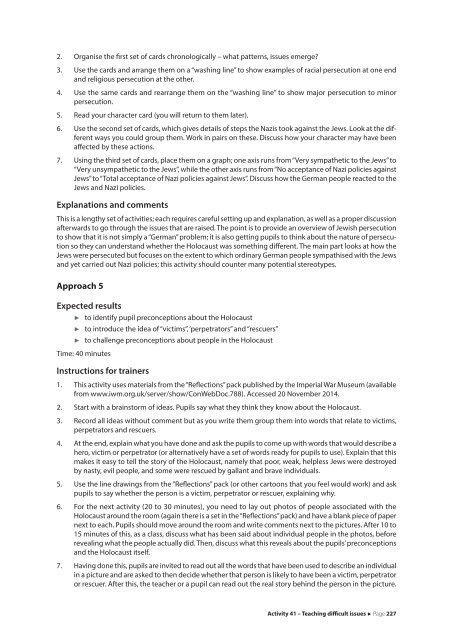TASKs for democracy
4NYw4W
4NYw4W
Create successful ePaper yourself
Turn your PDF publications into a flip-book with our unique Google optimized e-Paper software.
2. Organise the first set of cards chronologically – what patterns, issues emerge?<br />
3. Use the cards and arrange them on a “washing line” to show examples of racial persecution at one end<br />
and religious persecution at the other.<br />
4. Use the same cards and rearrange them on the “washing line” to show major persecution to minor<br />
persecution.<br />
5. Read your character card (you will return to them later).<br />
6. Use the second set of cards, which gives details of steps the Nazis took against the Jews. Look at the different<br />
ways you could group them. Work in pairs on these. Discuss how your character may have been<br />
affected by these actions.<br />
7. Using the third set of cards, place them on a graph; one axis runs from “Very sympathetic to the Jews” to<br />
“Very unsympathetic to the Jews”, while the other axis runs from “No acceptance of Nazi policies against<br />
Jews” to “Total acceptance of Nazi policies against Jews”. Discuss how the German people reacted to the<br />
Jews and Nazi policies.<br />
Explanations and comments<br />
This is a lengthy set of activities; each requires careful setting up and explanation, as well as a proper discussion<br />
afterwards to go through the issues that are raised. The point is to provide an overview of Jewish persecution<br />
to show that it is not simply a “German” problem; it is also getting pupils to think about the nature of persecution<br />
so they can understand whether the Holocaust was something different. The main part looks at how the<br />
Jews were persecuted but focuses on the extent to which ordinary German people sympathised with the Jews<br />
and yet carried out Nazi policies; this activity should counter many potential stereotypes.<br />
Approach 5<br />
Expected results<br />
to identify pupil preconceptions about the Holocaust<br />
<br />
to introduce the idea of “victims”, ‘perpetrators” and “rescuers”<br />
to challenge preconceptions about people in the Holocaust<br />
Time: 40 minutes<br />
Instructions <strong>for</strong> trainers<br />
1. This activity uses materials from the “Reflections” pack published by the Imperial War Museum (available<br />
from www.iwm.org.uk/server/show/ConWebDoc.788). Accessed 20 November 2014.<br />
2. Start with a brainstorm of ideas. Pupils say what they think they know about the Holocaust.<br />
3. Record all ideas without comment but as you write them group them into words that relate to victims,<br />
perpetrators and rescuers.<br />
4. At the end, explain what you have done and ask the pupils to come up with words that would describe a<br />
hero, victim or perpetrator (or alternatively have a set of words ready <strong>for</strong> pupils to use). Explain that this<br />
makes it easy to tell the story of the Holocaust, namely that poor, weak, helpless Jews were destroyed<br />
by nasty, evil people, and some were rescued by gallant and brave individuals.<br />
5. Use the line drawings from the “Reflections” pack (or other cartoons that you feel would work) and ask<br />
pupils to say whether the person is a victim, perpetrator or rescuer, explaining why.<br />
6. For the next activity (20 to 30 minutes), you need to lay out photos of people associated with the<br />
Holocaust around the room (again there is a set in the “Reflections” pack) and have a blank piece of paper<br />
next to each. Pupils should move around the room and write comments next to the pictures. After 10 to<br />
15 minutes of this, as a class, discuss what has been said about individual people in the photos, be<strong>for</strong>e<br />
revealing what the people actually did. Then, discuss what this reveals about the pupils’ preconceptions<br />
and the Holocaust itself.<br />
7. Having done this, pupils are invited to read out all the words that have been used to describe an individual<br />
in a picture and are asked to then decide whether that person is likely to have been a victim, perpetrator<br />
or rescuer. After this, the teacher or a pupil can read out the real story behind the person in the picture.<br />
Activity 41 – Teaching difficult issues Page 227


